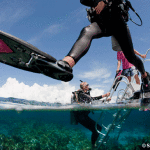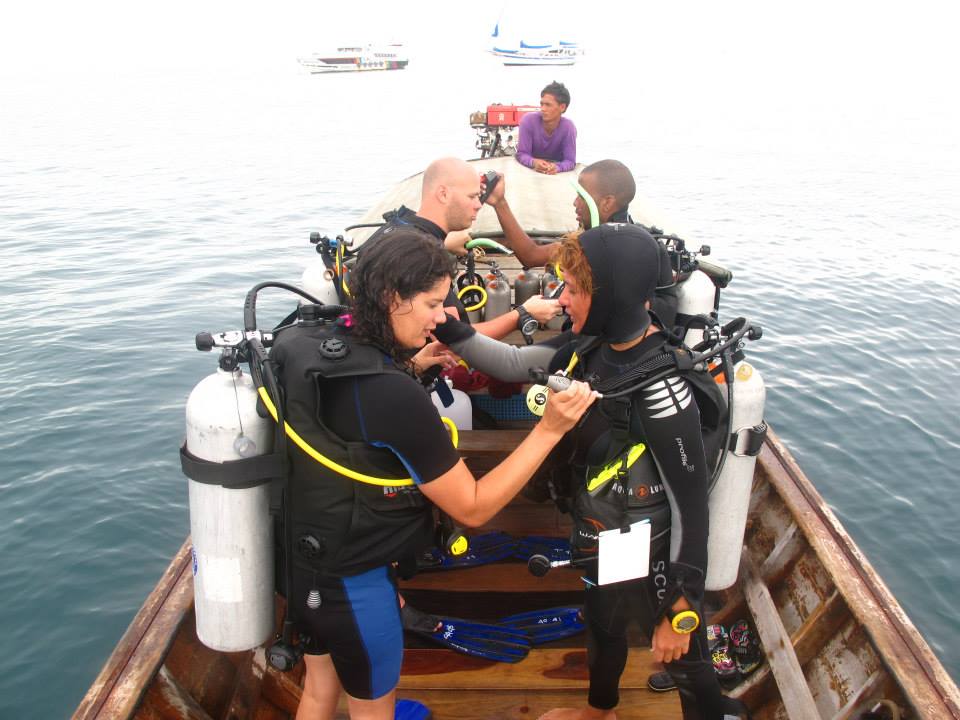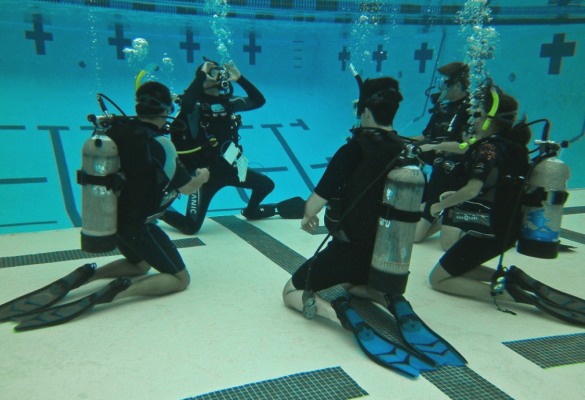Scuba Happy December Newsletter
accutane order online from canada
Water Entry Methods
http://justmusing.net/2007/09/27/threescore-and-ten/

Entry Methods
After you exit the bubble that is your scuba training, you’re faced with a whole world of different
types of diving. You’re next dive trip could have you diving from a live aboard, a small dive boat
or shore diving from a sandy beach or even an inland lake. Since chances are, you’ve only
learned the basic scuba entry and exit methods since your training, you’re sure to be faced with
some unfamiliar ways to get in the water to start a dive and exit the water after one at some point
or another. To anyone used to always doing the giant stride entry into the water, suddenly having
to do a backward roll off a small shaky boat can be a little intimidating. But this is due to the
unfamiliarity and lack of experience. Good news is, they’re all fairly simple once you’ve tried it.
Here’s a closer look at some Entry and Exit methods to brush up your scuba skills for
diving both from the shore and boats
BOAT DIVING ENTRY METHODS
The Giant Stride Entry
Most commonly used while diving off a dive boat with a
platform, but can also be used to step off a pier or jetty
where the water is deep enough, this method can is best
used only if the platform is steady.
– Kit up and don all your scuba gear on in the boat itself
– Put air in your BC to avoid making a negative descent
– Stand on the edge of the dive platform with the balls of your fins on the edge.
– Then holding your mask and regulator with the palm of your hand and fingers holding your
mask in place, take a big step off the platform putting one leg forward.
– Once in the water bring your legs together to return to the surface, recheck your gear and signal
the boat that you’re ok
TIP: Look up at the horizon when you step, to help maintain that upright position before you
take that step and avoid jumping or hoping as the aim is to get as far away from the
boat/platform as possible.
Backward Roll Entry
This is another common entry method and is preferred when diving from a RIB (Rigid Inflatable
Boat)or small unsteady boat. The water needs to be deep for this method of entry just like in the
giant stride entry.
– Put all your scuba equipment on in the boat itself
– Sit at the edge of the gunwale of the boat facing inwards with your tank facing the water
– Make sure no one or nothing is behind you in the water
– Then with your legs together bent at the knees, chin tucked in and one hand holding the mask
and regulator in place, lean back and let gravity do the rest
– With the weight of the tank and gravity doing it’s thing you’ll be pulled into a full somersault
and hit the water.
Controlled Seated Entry
The controlled seated entry method is best used where the water is too shallow for a giant stride
off the boat or where your boat/platform is low to the surface of the water or the platform is
unsteady. A good entry method for disabled or older divers
– Start by sitting up on the boat itself
– Sit at the edge of the boat/platform and using your hands on each side of you, lift yourself up
and outward with your hands and lower yourself into the water.
– Care should be taken while pushing yourself off the boat that you clear both yourself and your
tank from hitting the side of the dive boat or platform.
SHORE DIVING ENTRY METHODS
Beach Entry/ Surf Entry
Walking into the water may sound like an easy method of entry, but wading through the surf
backward while wearing heavy scuba diving equipment is no easy feat. Depending on the
condition and your waddling skills, you may keep your fins on or in your hand.
– Hold your fins securely with one hand. (For surf entries keep them on, along with your
regulator in your mouth and mask on).
– Walk slowly backwards into the water. Make sure that your tank is facing the water as you
enter the water to prevent yourself from falling face-first.
– Inflate your BC.
– Use your buddy’s assistance and support to put your fins on in the water.
– As soon as you are deep enough, gently submerge and move off into deeper waters.
Rocky Surface Entry
This is one of the toughest entries and can be quite nerve wracking for some, however, it’s not
very uncommon. It’s very important to note the conditions before such a dive as rough rocks
with high swells are a recipe for disaster if not while entry then potentially during exit as well.
– Avoid carrying any extra scuba accessories such as cameras or torches, so that you can keep
your hands free to steady yourself. If you require such gear make sure you can attach it securely
to your BC or it can be stowed away in pockets.
– Wear hard sole boots rather than soft booties for a better grip on the rocks and protection for
your feet.
– Find a stable rock closest to the water where it’s deep enough for entry and sit or lean against it
while securing your fins and mask.
– Sit down and edge your body towards the entry point slowly, in a seated position, until your
legs are in the water.
– Time your entry with a swell (if any) so that you hit the water at the top of the wave and allow
it to carry you out.
– Once in, fin hard to move away from the rocks.
Exit Methods
After you exit the bubble that is your scuba training, you’re faced with a whole world of different
types of diving. You’re next dive trip could have you diving from a live aboard, a small dive boat
or shore diving from a sandy beach or even an inland lake. Since chances are, you’ve only
learned the basic scuba entry and exit methods since your training, you’re sure to be faced with
some unfamiliar ways to get in the water to start a dive and exit the water after one at some point
or another. To anyone used to always doing the giant stride entry into the water, suddenly having
to do a backward roll off a small shaky boat can be a little intimidating. But this is due to the
unfamiliarity and lack of experience. Good news is, they’re all fairly simple once you’ve tried it.
BOAT DIVING EXIT METHODS
Hard/ High Boat Exit With a Ladder
It’s almost certain that if a dive boat has high sides or a raised platform, there will be a ladder to
help climb out of the water and get back into the boat. Depending on the conditions and type of
ladders provided, you can exit wearing your fins or you may have to take them off to climb it.
– Don’t make your way to the ladder if anyone is already on it or still climbing up, keep a safe
distance to the side as they may fall back.
– Always watch your fingers as you hold the ladder, you don’t want them getting caught between
the ladder and boat.
– If there are swell and depending on the conditions keep your mask and regulator in.
– Get a good grip on the ladder and climb up a couple of rings and pass up your weight belt first
or use whatever kit removal sequence you’ve been told to follow by the dive guide.
– After you take your weights off, you may take off your fins before proceeding to get in the
boat.
Small Boat Exit with No Ladder
To get out of a RIB or small boat or even a lower platform where no ladder is needed, you first
hand over your weight belt and take off your whole BC kit while in the water. After handing
these to a boat hand and keeping your fins on, you need to get a good grip with both your palms
on the side ridge of the boat or platform. Then timing your push with a swell (if any), kick up
with your fins as you pull yourself up, then twist and plop your behind on the ridge or platform
facing the water. It’s just like sitting up on a wall or getting out of a swimming pool.
SHORE DIVING EXIT METHODS
Beach Exit
– Make your way to shallow water until you are roughly hip-level with the water.
– Deflate your BC so that your feet are firmly on the ground
– Facing the beach, remove your fins using your buddy for support.
– Walk back to shore.
Surf Exit Method
– Determine the best route for entry and exit before the dive itself.
– Move as quickly as you can and stand up as soon as you are able.
– If you are not able to stand up comfortably, shuffle up the beach, allowing the breakers to push
you forward. Keep your hands in front of you to fend off obstructions.
– Avoid the highest part of the wave.
There are many ways to enter the water from any surface but remember the first rule “Choose the Safest Method” and always remember to help your buddy also, and thanks alot for reading this December newsletter, please feel free to send me requests for differing topics. Thanks Greg at Scuba Happy





